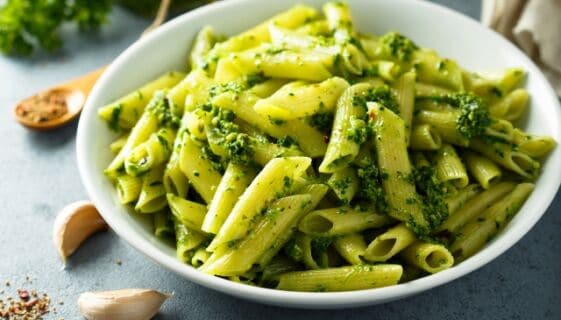In the kitchen, spring is a time of reawakening your senses. Our rice noodle bowl recipe will enliven your taste buds while taking them on an exotic flavor adventure. It is a delicious and nutritious meal packed full of colorful, crisp vegetables, delicate rice noodles, and an irresistibly creamy dressing topped with vibrant herbs. The herbs add depth and complexity to the dish as well as support a healthy digestion, aid the body in detoxification and provide anti-bacterial and antioxidant properties. This fresh and flavorful rice noodle bowl is the perfect quick and easy springtime dish that delivers big on tastes and textures as well as good-for-you ingredients.
Serves: 4
Ingredients
Bowls
- 1 12 oz package of vermicelli rice noodles
- 1 tbsp oil (sesame, olive, avocado, nut oils)
- 1 medium cucumber, sliced
- 1/2 red onion, sliced
- 1 bell pepper, sliced
- 1 medium carrot, sliced
- 1/2 cup radishes, sliced
- 1 avocado, pitted and sliced
- 2 cups shelled edamame, can be purchased frozen and thawed
- If you do not have edamame, you can use any cooked bean
- 2 cups red cabbage, thinly shredded
Garnish
- Fresh mint, cilantro and basil, chopped
- 1 cup mung bean sprouts
- 1-2 chilis, sliced
- 1/2 cup crushed peanuts
Dressing
- 1/2 cup peanut butter or any other nut/seed butter you prefer
- 1/4 cup rice vinegar
- 1 tsp maple syrup
- 1 clove garlic, minced
- 2 tbsp tamari, low sodium soy sauce, or coconut/liquid aminos
- 1 inch of grated fresh ginger or 1 tsp ginger powder
Directions
- Prepare the rice noodles according to package and then run under cold water to stop cooking. Add 1 tbsp of oil and mix with noodles so they do not stick together.
- Make the dressing by combining all ingredients to a bowl. Whisk until well combined or blend until smooth in a blender. Set aside.
- Prepare the vegetables.
- Building the 4 bowls: divide the rice noodles and place on the bottom of the 4 bowls. Top each bowl of noodles in a circular pattern with the cucumbers, onion, carrot, radishes, avocado, edamame, and cabbage. Sprinkle with fresh herbs, mung bean sprouts, chilis and peanuts.
- Serve the dressing on the side or drizzle over each bowl.
- Bowls can then be topped with extra protein of choice: grilled fish, shrimp, chicken, tofu, or sashimi grade fish.
Nutritional Information
Edamame: Also known as soy beans, edamame are one of the few plant-based protein options that is considered a complete protein (meaning they contain sufficient amounts of all essential amino acids). Soy beans have anti-inflammatory compounds and beneficial isoflavones that can protect the heart, improve insulin sensitivity, and reduce the risk of breast, digestive system, and prostate cancers.
Cucumber: One of the most hydrating foods to help the body with temperature regulation, physical performance and metabolism. Can also help with balancing blood sugar levels.
Bell Peppers: All colors of bell peppers are from the same plant. A bell pepper starts out green and as it ripens will become yellow, orange or red depending on the variety. As the bell pepper ripens there is also an increase in the nutrient concentration, with orange and red having the highest. Bell peppers have high amounts of antioxidants called carotenoids that help protect cells from oxidative damage.
Carrots: Packed full of Beta-carotene (precursor to vitamin A). Vitamin A is integral for vision and immune function, as well as skin and bone health. Beta-carotene is a powerful antioxidant that can reduce inflammation and boost immune function by increasing disease-fighting cells in the body and assists cells in protection against viruses. Scientists have also reported that carotenoid-rich foods (orange foods) can help reduce the risk of heart disease and cancer (especially in the lungs, esophagus, and stomach), and can improve immune system function. Carrots are also an excellent source of vitamin C, an antioxidant that helps destroy free radicals and support the body’s natural immune response, by reducing oxidative stress.
Radish and Cabbage: Cruciferous vegetables that have anticancer properties. They are also great sources of fiber to help with balancing blood sugar and support gut health.
Avocado: Avocados are actually a type of berry that provide an excellent source of fiber, potassium, B vitamins and healthy fats. They have been shown to support heart health, improve digestion, strengthen eye health, reduce inflammation, balance hormone levels, improve mood, balance blood pressure and improve nervous system function. They are also a great gut-friendly food.
Mint: It is one of the rare herbs that is versatile enough to be used with equal success in sweet and savory dishes. The menthol in mint is a natural decongestant, and it also helps in relieving a sore throat. It aids digestion and gives relief to bloating and flatulence. It helps in alleviating allergy symptoms and helps to relieve nausea and headache.
Basil: There are many types of basil. Sweet basil is the most common basil used in Mediterranean cuisine and most of the world. Holy basil, or tulsi, is revered by the Hindus. Other species include Thai basil and lemon basil, both commonly used in South East Asia. Recent studies show that basil is rich in phenolic compounds and polyphenols. It is rich in antioxidants. It helps in reducing inflammation, has anti-aging and anti-bacterial properties.
Cilantro: The most commonly used herb in the world. The flavor of cilantro may be the most divisive herb in the culinary world. Cilantro has a refreshing, citrus flavor. It detoxifies the body, by getting rid of unwanted toxins. It can aid digestion and prevent stomach disorders like nausea and vomiting. It helps to prevent macular degeneration and cataracts of the eyes.
Nut and Seed Butters: Great source of plant-based protein, fiber and healthy fats, which can reduce your risk of heart disease and improve overall health. Very important to check the ingredient list to ensure there are no added stabilizers or sugar.
Garlic & Onion: Considered a prebiotic, meaning it feeds the “good” bacteria in our gut and promotes a healthy digestive system. Research supports that the compounds in garlic, such as allicin, have antioxidant, anti-inflammatory, antimicrobial, and cardioprotective properties. If you chop your garlic 10-15 minutes before using, it will have the maximum amount of active allicin.
Ginger: Shown to be heart healthy and assist with blood sugar control by lowering cholesterol and blood sugar levels. Ginger also improves various heart disease risk factors. It supports gut health and is highly effective in promoting digestive health and chronic indigestion. Its powerful anti-inflammatory properties and can ease joint pain and stiffness. It is also antimicrobial and can lower risk of infections and boost the immune system.



 Ananda Kaplan
Ananda Kaplan 

